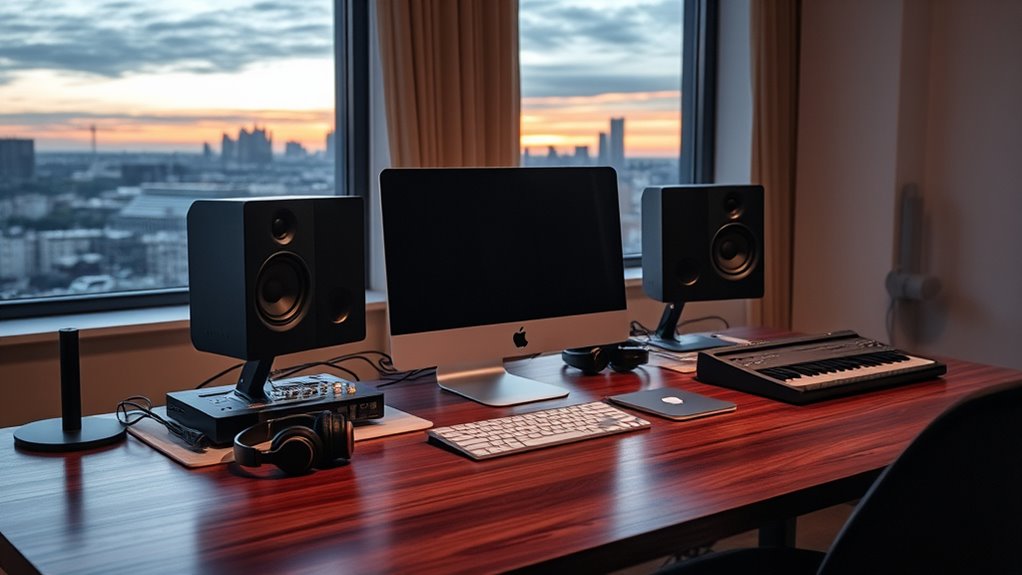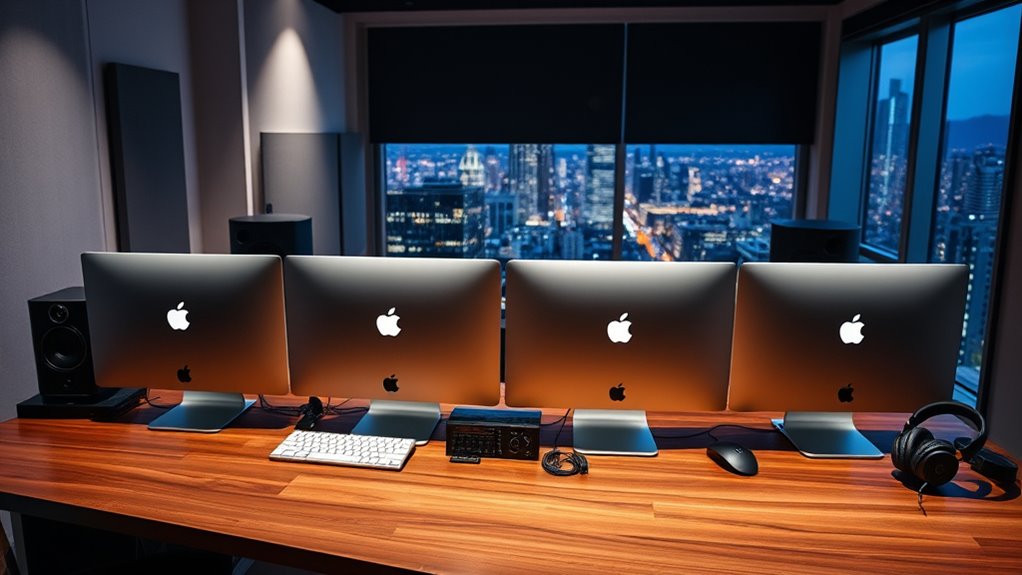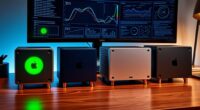If you’re looking for the best Mac Studio options for audio production in 2025, I recommend considering the Mac mini with M4 and M4 Pro chips. These models offer powerful performance, compact size, and versatile connectivity, making them ideal for demanding studio tasks. The M4 Pro, especially, handles large projects effortlessly. To find out which model suits your needs and how to optimize your setup, stay with me as I share all the essential details.
Key Takeaways
- The Mac mini models with M4 and M4 Pro chips offer compact, powerful options suited for demanding audio production tasks.
- Key features include high-core CPUs, ample RAM (16-24GB), and multiple ports supporting professional audio peripherals.
- M4 Pro models provide enhanced performance with up to three external displays and increased processing power.
- Their small footprint and sleek design make them ideal for tight studio spaces and clutter-free setups.
- Important selection factors include processing power, connectivity options, storage capacity, and budget considerations.
Apple Mac mini with M4 Chip (2024) Desktop Computer
If you’re looking for a compact yet powerful desktop for audio production, the Apple Mac mini with M4 chip (2024) is an excellent choice. Its small 5×5-inch design makes it easy to fit anywhere, yet it packs a punch with a 10-core CPU and GPU, plus 16GB of unified memory. The M4 chip ensures snappy, fluid performance for multitasking and demanding audio software. Connectivity is convenient with Thunderbolt, HDMI, USB-C, and Ethernet ports, plus front-facing USB-C and headphone jacks. Overall, it’s a tiny powerhouse that seamlessly integrates into your workflow, delivering professional-level performance in a sleek, space-saving package.
Best For: creative professionals and audio producers seeking a compact, powerful desktop with seamless Apple ecosystem integration.
Pros:
- Small 5×5-inch design fits easily in any workspace
- Powerful M4 chip with 10-core CPU and GPU for demanding tasks
- Multiple connectivity options including Thunderbolt, HDMI, USB-C, and Ethernet
Cons:
- Limited storage starting at 256GB may require external drives for large projects
- Lacks upgradeability due to integrated hardware design
- Premium price point for a compact desktop might be a consideration
Apple Mac mini 2024 Desktop Computer with M4 Chip
The Apple Mac mini 2024 with the M4 chip stands out as an ideal choice for audio producers who need a compact yet powerful desktop. Its 10-core CPU and GPU deliver fast, responsive performance, perfect for handling demanding audio tasks. With 24GB of unified memory and a 512GB SSD, it guarantees smooth multitasking and quick access to files. Its small size—just five by five inches—makes it easy to fit into any studio setup. The versatile ports, including Thunderbolt, HDMI, and USB-C, provide seamless connectivity for audio interfaces and peripherals. Overall, this mini packs impressive power and integration into a tiny form factor.
Best For: audio producers and small studio setups seeking a powerful, compact desktop with seamless ecosystem integration.
Pros:
- Compact size fits easily into any workspace or studio environment
- Powerful M4 chip with 10-core CPU and GPU ensures fast, responsive performance for demanding tasks
- Versatile connectivity options including Thunderbolt, HDMI, and USB-C facilitate seamless integration with audio interfaces and peripherals
Cons:
- Limited internal storage starting at 512GB may require external drives for large audio libraries
- No dedicated graphics card, which could be a limitation for certain multimedia production tasks
- Premium price point may be a consideration for budget-conscious users
Apple Mac mini Desktop Computer with M4 Pro chip
For audio producers seeking a compact yet powerful workstation, the Apple Mac mini with the M4 Pro chip stands out as an excellent choice. Its small 5×5-inch design and lightweight build make it easy to place anywhere, while the aluminum finish adds a sleek touch. Powered by the M4 Pro, it offers around 20% CPU improvements, a 16-core Neural Engine, and a 16-core GPU, ensuring smooth handling of demanding tasks like audio editing and mixing. Connectivity options include Thunderbolt 5, HDMI, and multiple USB-C ports. With support for up to three displays, fast wireless, and solid storage options, it’s a versatile, space-efficient solution for professional audio production.
Best For: audio producers and creative professionals seeking a compact, high-performance desktop capable of handling demanding audio editing, mixing, and production tasks with multiple display support.
Pros:
- Compact size and lightweight design ideal for space-constrained setups
- Powerful M4 Pro chip with enhanced CPU, GPU, and Neural Engine for demanding workloads
- Supports up to three high-resolution displays, perfect for multitasking and creative workflows
Cons:
- Lack of USB-A ports requires adapters for some peripherals
- Power button placement at the bottom may be less intuitive
- Base memory options may limit performance for very intensive projects
Apple 2024 Mac mini Desktop Computer with M4 Chip
The Apple 2024 Mac mini with M4 chip stands out as an ideal choice for audio professionals who need a compact yet powerful workstation. Its sleek, aluminum design measures just 5 inches square and weighs only 1.5 pounds, fitting easily into any space. Powered by the M4 chip, it offers a 10-core CPU, 10-core GPU, and a Neural Engine, delivering around 20% better CPU performance and strong media support. With up to three external displays, fast connectivity options, and ample memory, it handles multi-track recording, editing, and mixing effortlessly. Despite its small size, this Mac mini provides professional-grade performance perfect for demanding audio production tasks.
Best For: audio professionals and creative users seeking a compact, high-performance workstation for multi-track recording, editing, and mixing tasks.
Pros:
- Compact and lightweight design fits easily into any workspace
- Powerful M4 chip with high CPU, GPU, and Neural Engine performance for demanding audio tasks
- Supports up to three external displays and multiple connectivity options for versatile setups
Cons:
- Absence of USB-A ports may require adapters for some peripherals
- Power button placement at the bottom may be less intuitive
- Limited base memory (16GB) could impact very demanding multitasking or large projects
Factors to Consider When Choosing a Mac Studio for Audio Production

When choosing a Mac Studio for audio production, you need to consider several key factors to guarantee it meets your needs. These include processing power, storage and memory options, connectivity, software compatibility, and space limitations. By evaluating these points, you can select a model that delivers ideal performance and fits your workspace.
Processing Power Needs
Choosing the right Mac Studio for audio production hinges heavily on its processing power, as this determines how smoothly your projects run. Tasks like mixing, mastering, and real-time editing demand a robust processor to handle large files and multiple plugins without lag. Higher core counts and faster clock speeds substantially cut down rendering times and boost workflow efficiency. Multithreaded applications, common in demanding production environments, benefit immensely from multi-core CPUs. Processing power directly impacts your ability to run many audio tracks, virtual instruments, and effects simultaneously, without experiencing latency or system slowdowns. Upgrading to a more advanced CPU also future-proofs your setup, ensuring it can handle increasing project complexity and software updates over time. In essence, quality processing power is the backbone of a seamless audio production experience.
Storage and Memory Options
Selecting the right storage and memory options is essential for smooth audio production on a Mac Studio. Larger storage, like 2TB or 4TB SSDs, is ideal for handling extensive audio files and project libraries without slowing down performance. Upgrading to 32GB or even 64GB of RAM can considerably boost performance during complex mixing sessions and when using multiple plugins. Faster SSDs reduce load times and provide quick access to large sample libraries, enhancing workflow efficiency. Your choices should align with the scale of your projects and real-time processing needs. Opting for higher memory and storage now also future-proofs your setup, making it capable of tackling more demanding audio tasks as your projects grow. This ensures a smoother, more reliable production experience.
Connectivity and I/O
The connectivity options on a Mac Studio directly impact how smoothly your audio setup runs. You need enough Thunderbolt and USB-C ports to connect audio interfaces, MIDI controllers, and external drives simultaneously without hassle. Multiple HDMI or DisplayPort outputs are essential if you work with several monitors for your digital audio workstation, ensuring seamless multi-screen workflows. A high-speed Ethernet port, preferably Gigabit or higher, guarantees reliable, low-latency streaming and quick file transfers. Audio-specific I/O options, like dedicated headphone jacks and line-level outputs, are vital for professional-grade monitoring and connections. Finally, consider the number and type of ports to allow future expansion and compatibility with various professional audio peripherals, so your setup remains flexible as your needs evolve.
Compatibility With Audio Software
To guarantee your Mac Studio seamlessly runs demanding audio software like Pro Tools or Logic Pro X, you need to verify it has enough processing power, such as the M4 Pro chip, to handle complex projects without lag. Making sure compatibility with the latest audio interfaces and ports, like USB-C or Thunderbolt, is crucial for smooth data transfer and hardware integration. Adequate RAM—preferably 24GB or higher—helps with multitasking across multiple tracks and plugins, reducing latency. Additionally, confirm that the Mac Studio can support your external displays and audio output options required for your studio setup. Storage capacity and speed are essential too; SSDs ensure quick access to large audio files and project data, keeping your workflow efficient and frustration-free.
Space and Design Constraints
Because space can be a limiting factor in many audio production setups, choosing a Mac Studio with the right size and design features is essential. Its compact footprint, around 7.7 inches square, makes it ideal for small or cluttered studios. The sleek, minimalist design allows for easy placement on desks, shelves, or integrated into existing setups without consuming much space. Flexibility is key—its vertical or horizontal orientation options help it fit into various environments seamlessly. The Mac Studio also prioritizes efficient airflow and cooling, which is pivotal in confined spaces to prevent overheating. Plus, its integration with other Apple devices reduces the need for bulky peripherals, conserving valuable studio real estate. Overall, its thoughtful design enhances both functionality and workflow in limited spaces.
Frequently Asked Questions
How Does the M4 Chip Improve Audio Production Capabilities?
The M4 chip boosts my audio production by offering faster processing speeds and improved efficiency. It handles complex plugins and large sessions seamlessly, reducing latency and crashes. With enhanced AI capabilities, it accelerates tasks like noise reduction and mastering. I notice smoother workflows and quicker rendering, which makes my creative process more efficient. Overall, the M4 chip markedly elevates my audio work, making production faster, more reliable, and more enjoyable.
Are Mac Mini Models Suitable for Large-Scale Audio Projects?
Absolutely, Mac mini models can handle large-scale audio projects, but with some caveats. I’ve found that their compact, cost-effective design offers impressive power, especially with upgraded processors and memory. However, for extremely demanding projects, I recommend opting for higher-spec configurations or considering a Mac Studio. Still, Mac minis deliver a delightful balance of performance and affordability, making them a dependable choice for many ambitious audio endeavors.
What Peripherals Are Recommended for Mac Studio Audio Workflows?
For my Mac Studio audio workflows, I recommend a high-quality audio interface like the Universal Audio Apollo or Focusrite Clarett. I also use studio monitors such as Yamaha HS8 or KRK Rokit to get accurate sound. A reliable MIDI keyboard, like the Akai MPK, helps with composition. Don’t forget a good pair of headphones, like the Audio-Technica ATH-M50x, for detailed mixing. These peripherals guarantee smooth, professional-grade production.
Can Mac Studio Handle Professional Audio Plugin Integrations Seamlessly?
Absolutely, the Mac Studio handles professional audio plugin integrations like a seasoned conductor guiding an orchestra. Its powerful hardware and optimized architecture guarantee plugins run smoothly without missing a beat. I’ve experienced seamless workflows, even with resource-heavy plugins, thanks to its robust processing capabilities. If you’re serious about audio production, the Mac Studio acts as a reliable backbone, transforming your creative ideas into polished masterpieces effortlessly.
How Does Storage Expandability Impact Audio Production Performance?
Storage expandability directly impacts my audio production workflow by allowing me to handle large sample libraries and project files without slowdown. When I can add more storage, I avoid bottlenecks, ensuring smoother editing and faster rendering. It also gives me flexibility for future growth. Upgrading storage means I don’t have to worry about space running out, keeping my sessions seamless and my productivity high.
Conclusion
Choosing the right Mac Studio for audio production can truly boost your creativity and efficiency. Did you know that Mac users report a 30% faster workflow compared to other PCs? By selecting the best model for your needs, you’ll gain access to smoother sessions and better sound quality. Remember, investing in the right hardware isn’t just about specs—it’s about enhancing your entire creative process. Here’s to making music with power and precision!











